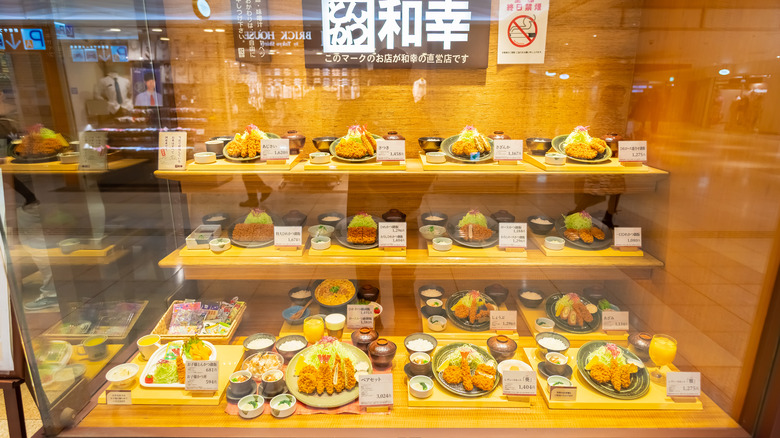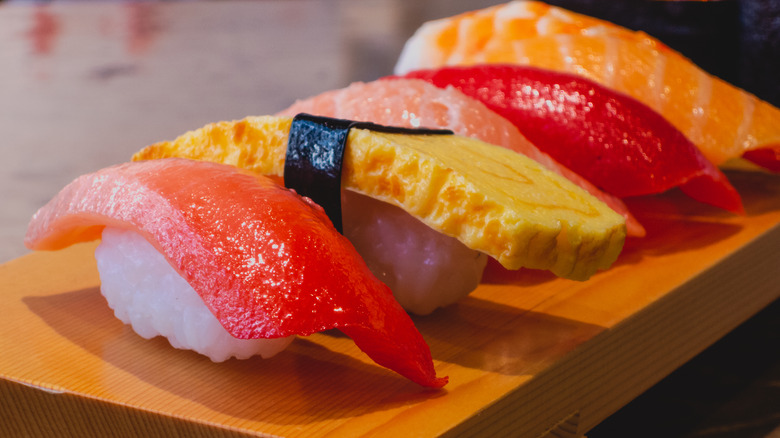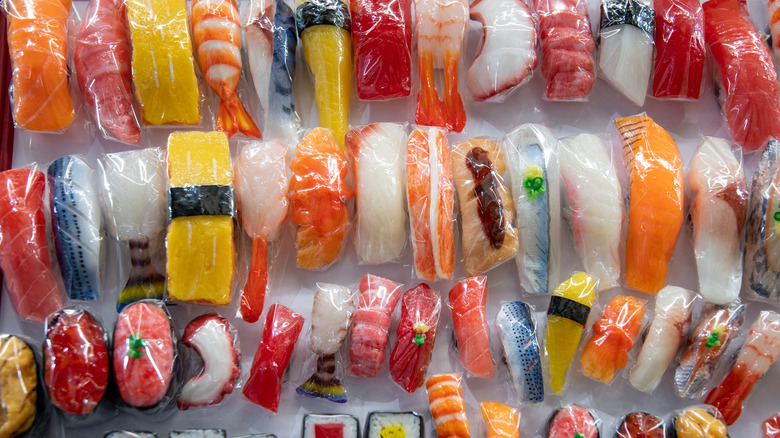The Reason So Many Restaurants In Japan Have Plastic Food On Display
Most restaurants in the west may be content to display a well-designed, artfully written menu that showcases the best they have to offer, but their Japanese counterparts go the extra mile. They put out eye-catching displays of plated specials that range from starters and sides, to mains, and even in some cases, carefully crafted beverages — all in the hope of attracting diners.
The uninitiated may wonder how much food is potentially wasted especially if the displays need to be changed as soon as the food starts to look manky, but those who frequent Japanese restaurants will say the displays are par for the course, and they have been so for more than 100 years, per Deutsche Welle.
The practice of showing off food samples — which the Japanese call "sampuru" — was first recorded in 1917 and were made with wax by a manufacturer of models named Soujiro Nishio (via TKSST and Deutsche Welle). The models were seen as particularly creative, since restaurants didn't really use menus during that time. Making food wasn't Nishio's main job, as journalist Yasunobu Nose, who has written about this highly specialized industry points out (via Japan Daily Press). "The original craftsman was working for doctors and making models for pathological studies, such as skin diseases and human organs, before he was asked to make food samples for a restaurant," Nose says.
Most of the fake food used at Japanese restaurants is hand made
But while Nishio might have been the first, the man who deserves the credit for making the food models what they are today is Takizo Iwasaki, whose company Iwasaki Be-I was established in 1932, and is still the lead supplier of plastic and wax food. Deutsche Welle says Iwasaki Be-I provides as much as 60% of all the realistic fake food dishes found across the country.
Sampuru are, for the most part, handmade using non-biodegradable plastic, or PVC, and while there are ready-made pieces of fake sushi or tempura that can be bought off the shelves, most of the Japanese dishes you see in restaurants are custom, made from molds created with actual dishes from restaurants themselves, per Tony McNicol.
To make fake food look specially realistic, dishes are hand-colored using paint or air brushes. One worker says, "Leaves are the most difficult ... and raw ingredients... That's why Japanese food is so hard." And because so much work goes into making sampuru — these pieces of food art don't come cheap. For instance, NPR says a display model of beer could set a restaurant owner back by $150.
Japanese fake food isn't just used as a marketing tool anymore
ANA says the Japanese themselves aren't sure why restaurants appear to be willing to spend large amounts of money to decorate their window displays with plastic copies of the food they serve. It is believed that the trend peaked after World War II when restaurants had begun serving both Japanese and Western-style dishes, so it would have made it easier for customers — both local and international — to know what they were eating if they could "see" it first.
These realistic food samples might have started out as marketing and advertising tools, as well as visual aids for restaurants, but they serve a new purpose these days. Tourists appear to be all over the samples and consider them to be unique souvenirs. Deutsche Welle says shoppers can pick up a range of plastic foods from doughnuts to cakes, and from eggs to pieces of fruit. One manufacturer says buyers are particularly interested in spaghetti dishes, which he calls "our most popular design."


